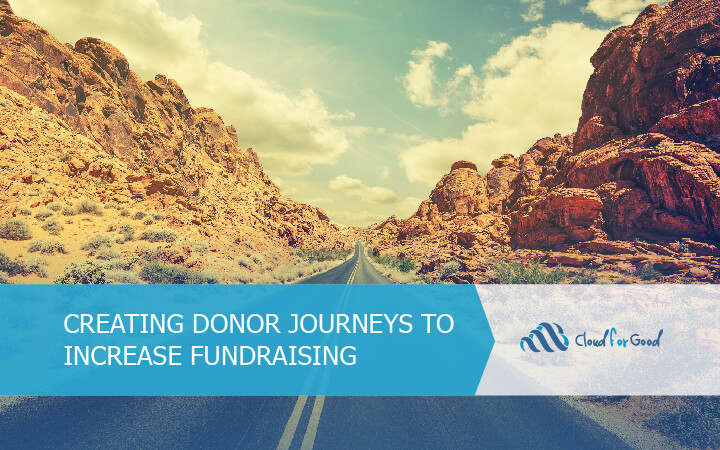This post first appeared on the Salesforce.org blog.
Nonprofit Fundraising: Then and Now
Back in the day, nonprofits used the “Donor Funnel” as a way to move donors along an established path from less-to-more engaged (and invested) in their mission. These conversion funnel models were the foundation for donor communications and engagement campaigns. Today, with significant changes to the digital communication landscape, savvy organizations are pivoting to better engage their supporters. New tools like Salesforce Marketing Cloud’s Journey Builder allow sophisticated, intelligent donor journeys to replace the funnel.
The funnel concept was simple enough: begin with awareness, and move donors through a set of stages towards a goal of active commitment. A well-intentioned example of funnel-centric communications would be the “welcome drip campaign,” triggered by an event attendance or web form submission. The first email might be sent right away (and automatically!), with a follow-up email after three days, then another email seven days later. Each email brings with it a wealth of new information and ways to get involved. Sounds great, right?
Think about this, though: a static model like the traditional drip campaign has to compete with dynamic, personalized messages from media-savvy corporations. Email inboxes fill quickly, and getting the messages out—to influence nonprofit constituents, advocates, and donors–is harder than ever before. Nonprofits increasingly are turning to sophisticated communication tools to make their messages heard.
Comparing the Funnel Approach to Donor Journeys
If you want to improve your fundraising, consider shifting from a funnel approach to a donor journey. This allows for more sophisticated and personalized interactions. Let’s compare the donor funnel to a donor journey:
| Stages are defined by the model, according to a static plan | Paths are laid out to accommodate a variety of donor behaviors |
| Communications are pushed out on a predefined schedule | Communications are delivered to the donor based on actual donor behavior, in near-real time |
| Channels and delivery of content is fixed | Donor preferences are honored with regards to communication channel, frequency, and content |
| Communications may be personalized with certain fields or dynamic content | Nearly every aspect of the communication can be personalized |
| Communication content is independent of donor behavior | Donor behavior such as opens, clicks, and donations can alter subsequent communications |
How do you create nimble communication strategies for better fundraising?
The benefit of journeys is clear–we get flexible, current, meaningful conversations with donors. Interactions are automated and intelligently informed by the actions donors take. For these reasons and more, over 60% of nonprofits plan to increase their investment in marketing automation in 2017, according to Cloud for Good’s State of Salesforce Within the Nonprofit Sector 2016 Report. The top three objectives of those surveyed for the upcoming year are to raise more funds, expand programs and adopt new technologies.
To do so, nonprofits are increasingly turning to the Journey Builder tool in the Salesforce Marketing Cloud. Journey Builder is a marketing automation tool that maps, manages, and measures the impact of donor engagement journeys. Marketing Cloud doesn’t replace Sales Cloud (Salesforce), but the two are more powerful when combined.
Here are some FAQs you might have, and answers:
Where do I keep detailed donor information?
Salesforce CRM (Sales Cloud) is the ultimate “source of truth” for donor information. A donor’s Contact record in Salesforce holds important contact information, and can be extensively configured to hold custom demographic, giving history, donation propensity, and engagement information. This configuration is made seamless with the free and powerful Nonprofit Success Pack. The Salesforce ecosystem provides nonprofits the ability to raise more funds, communicate and engage more efficiently.
Where do I create those donor journeys?
Salesforce Marketing Cloud’s Journey Builder tool is the nonprofit digital marketer’s best friend. Marketing Cloud as a platform allows communications across email, social, mobile, and web channels. Journey Builder allows communications teams to weave together a variety of donor engagement paths, which are responsive and personalized to the donor’s behavior. Journey Builder provides Journey Maps, visual renderings of the journey that are what whiteboarding models wanted to be when they grew up. These drag-and-drop overviews help map out the twists and turns a donor may make in their engagement. Communications teams can set goals for their Journeys, and gain valuable insights from related reporting.
How do Salesforce CRM (Sales Cloud) and Journey Builder (Marketing Cloud) tools integrate?
The integration between Salesforce Sales Cloud and Marketing Cloud relies on a robust, intelligent connection known as the Marketing Cloud Connector. With the Marketing Cloud Connector, a seamless connection exists to access donor information and segmentation details from Salesforce Sales Cloud. Marketing Cloud can use that rich donor information housed in the CRM in an intelligent way, sending messages on the right channel, at the right time, to get the right message across.
Data Stream is a tool to bring Salesforce information into Marketing Cloud, supporting synching of CRM data and providing a rich basis for Journeys. This point-and-click tool defines data from CRM—including custom objects—and maps data relationships. Anything tracked in Sales Cloud such as donations, attendance, web visits, birthdays and anniversaries— nearly any record created or updated in your CRM—can trigger can kick off individualized journeys.
Journey Builder is a force multiplier for donor engagement
With robust marketing tools, your team can be empowered to reach out in new and more meaningful ways to supporters. Sophisticated testing tools and insightful metrics can inform increasingly efficient communication efforts. Scalable systems and automation allow sophisticated journeys without ongoing manual management. At the end of the day, the goal of having engaged supporters who connect with your organization in a meaningful way is closer than ever before.
You may also be interested in reading:





